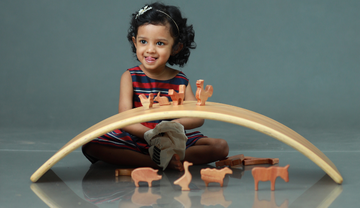What is it?
The Balancing board, also known as the balance board, the curvy board or the wavy board is a versatile, open-ended gross motor toy. It is really a family toy and can be used indoors which is a blessing in these times where children can’t get out. It has numerous uses for physical and mental health development and limitless possibilities for open-ended play.

How will it help my child?
- helps children understand their own bodies and the ways it can move (proprioception)
- great for vestibular development and spatial orientation
- aid in the development of body equilibrium, that is, a sense of balance
- help develop the body’s core strength and stability
- beneficial for the development of whole-body coordination
- excellent for the leg, ankles, calves, knees and hips
- builds appropriate body posture
- helps release pent up energy in a productive manner
- builds self-confidence as children get better at balancing with it with practice
- builds resilience as it inspires them to try many times to learn a skill
- encourages creativity and imagination as it offers unlimited open-ended play opportunities
- kindles the child’s sense of curiosity
- works both for quiet moments of individual play, exciting collaborative play and family fun times
- can be combined with other forms of exercise, dance or yoga and even be used by the adults
- can be taken to different parts of the house or easily carried while travelling
How do children play with it?

Although it is designed to be a balance board, the open-ended nature of the toy inspired children to use it in multiple ways during play. The board grows with your children and children play with the Balancing board differently during each age. Here is a list of things we’ve seen children transform the Balancing board into. We would love to hear what our children come up with.
- A reading nook
- A doll bed
- A bridge for their cars
- A see-saw
- An elephant’s back
- A Slide
- A Cradle
- A Seat
- A Boat
- A Shelter for toy animals
- A surfboard
- A climbing challenge
- A mountain
- A cave
- A ball run
- A Ramp
- A doorway
- A tunnel
- A table
- Dance platform
- A doll rocker
- A Fort
- Yoga helper
- A swing
- A hammock
- A magic carpet
- A puppet stage
Ways to increase the challenge
Although children come up with their own ways of increasing the Balancing board challenge, here are some challenges you can provide, especially if your child is older.
- Place a ball in between both the legs and the challenge is to not let the ball roll out of the board but keep moving. You can increase the number of balls as children gain more mastery over this activity
- As the children are balancing on it, throw a softball at them that they have to catch and throw it back to you – all this while they can't stop moving
- Blow soap bubbles at them when they are rocking on the Balancing board and ask them to clap and burst the bubble.
- Ask them to try juggling some softballs from hand-to-hand while rocking on the board
- Set up a bucket a few metres away as challenge them to throw softballs into the bucket as they rock on the board. Increase the distance between the board and the bucket as they gain mastery over this.
- Ask your children to try dribbling a basketball as they balance on the board
-
Set up something on the floor for them to bend and pick up as they are rocking on the board
Some things to keep in mind
While the Balancing board guarantees hours of fun for the whole family, here are a few pointers to make play safe and to keep the board in great condition for many years.
- Explain to children never to keep their hands or toes at the edges of the board as this man cause injury
- Always be around and supervise your child’s play
- Balancing boards are designed for flat surfaces and not slopes or stairs
- Show your child to always use the Balancing board when there enough free space available all around them
- Balancing boards work best with bare feet. Wearing socks might make the surface slippery and unsafe.
- If your child is using the wobble in an inverted position to walk or climb on it, show them to stay in the middle as walking on the edges may cause it to tip over
- If you are using the wobble on a surface that can be slippery and not provide enough traction or rough and damage the board, place a non-slip mat under it.






